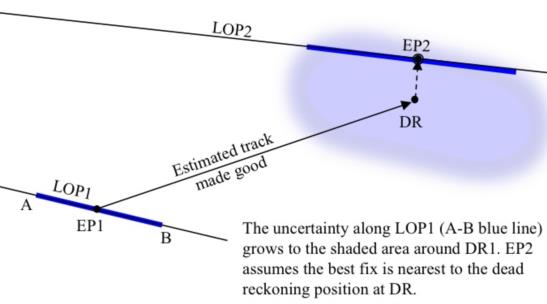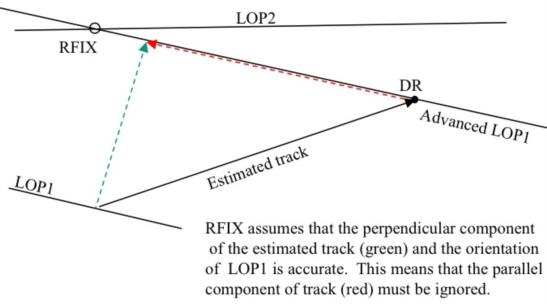
NavList:
A Community Devoted to the Preservation and Practice of Celestial Navigation and Other Methods of Traditional Wayfinding
Eprf Vs, Trf
From: John Karl
Date: 2009 Dec 19, 18:54 -0600
From: John Karl
Date: 2009 Dec 19, 18:54 -0600
EP Running Fix vs. the Traditional Running fix -- Part II. Yes Rob, there are explicit assumptions in both methods. Here's a summary of the way I see it: (1) To correct error in the DR, the EP running fix (EPRF) uses all possible information in the newly acquired LOP (the distance perpendicular to the new LOP), while retaining all possible info in the DR that is not constrained by the new LOP (the distance along the new LOP). These are examples of the kinds of explicit assumptions universally valid in estimation problems. See the first figure below. (2) The traditional running fix (TRF) explicitly assumes that the orientation of LOP1 is unchanged and that the estimated track component perpendicular to LOP1 is accurate. The first assumption is good in most celestial applications (although not in others, such as in some coastal running fixes). The second assumption means that the component of estimated track parallel to LOP1 is completely ignored. This seems to be an arbitrary assumption, which is never allowed in estimation problems. See the second figure below. Now let's muse a bit on these TRF assumptions: Consider after running a couple of days with no sights, we see the sun peek through the clouds. We think to ourself, "This is really going to be wonderful. Somehow that sun line will know that my careful dead reckoning over the past couple days is correct perpendicular to my last moon line, And in addition, that old sun will know what my DR error is along my old moon line. All this, even though the sun can't even know the moon- line orientation! Ain't that old-man sun marvelous? I guess I'll muse on him some more". And Rob I agree, it seems that since both methods are estimates, and both would give the correct result if there were no DR errors, the navigator should be able to use either method to improve DR estimates. But again, the TRF is flawed because of its assumptions. Since it gives the same RFIX for all tracks with arbitrary components along LOP1 (and having the same track component perpendicular to LOP1), it can't yield any information about this parallel component. When one component is missing, we know nothing about the revised track. On the other hand, the EPRF uses only the DR estimate, corrected by LOP2, which is indeed a measure of the accuracy of our dead reckoning. Specifically, the along-track cross-track components of the line from DR to EP2 in the first figure would be the subject of our revised DR thinking. JK -- NavList message boards: www.fer3.com/arc Or post by email to: NavList@fer3.com To , email NavList+@fer3.com








